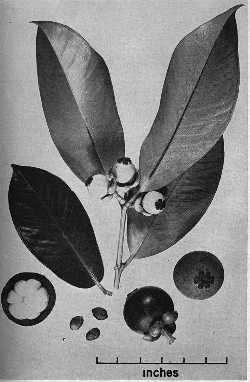
Picture and text courtesy of USDA
USDA: 11
Frost Tolerance: Very tender, killed at 37°F (2°C)
Heat Tolerance: Afternoon shade
Sun Exposure: Full sun to light shade
Origin: Malaysia, Indonesia
Growth Habits: Evergreen tree slowly growing up to 30 to 40 feet tall (9 to 12 m)
Watering Needs: Regular to abundant water
Propagation: Seeds, air layering
No other tropical fruit has been so highly praised as the Mangosteen. The combination of beautiful coloring and interesting shape with a delicate, enticing flavor ranks it above all other fruit of the Asiatic tropics. The mangosteen has none of the insipid flavor ascribed to many tropical fruits, and it is almost universally liked by the individuals tasting it for the first time.
The mangosteen is thought to be native to the Malay Peninsula and to the Molucca and Sunda Islands. It is extensively cultivated in the more humid parts of the Asiatic Tropics. The tree is an attractive columnar or pyramidal slow growing evergreen, which attain a height of 30 to 40 feet (9 to 12 m). It has a strong central trunk with evenly spaced side branches, which become pendent at the tips as the tree ages. The leathery leaves are opposite, short stalked, and elliptic oblong with acuminate tips. The upper surface is bright shining green. The under surface is a dull green. All parts of the plant are without pubescence.
Blooming Habits:
The 2-inch fleshy flowers are borne terminally upon the branchlets.
Fruiting Habits:
The subglobose fruit, which is 1.5 to 3 inches in diameter (4 to 8 cm) ripens a dark reddish-violet to purple color. It may be smooth or marked with brownish scars. The thick tough pericarp or rind exudes a bitter yellowish resin, especially when unripe. The calyces and stigmatic lobes persist until the fruit is ripe, and the number of stigmatic lobes is indicative of the number of internal segments, which are easily separated from the rind. The juicy pulp has a sweet-tart flavor, which is generally accepted by people from temperate and tropical climate alike. Usually only 1 to 3 of the segments contain seeds, which are oblong bodies of about 1 inch long and 0.3 inches in diameter (2.5 x 0.8 cm).
Culture:
The mangosteen tree grows well in fertile clay or loam soils. Good drainage seems to be important, but the tree does well near lakes or streams. While the high humidity and rainfall seems to benefit the trees, they will produce in areas having a dry season of several months. Fertilization with animal manure seems to benefit the trees.
Propagation:
The mangosteen is best propagated by seeds, which should be planted within a few days after removal from the fruit. Flats of peat moss have proved excellent for germinating the seeds. When the plant reaches the 2-leaf stage, they should be moved to heavily shaded outdoor nurseries. After the plants become established, the light might be graduall increased to about 50% of full sunlight. After 2 to 3 years in the nursery, the trees may be transplanted to the garden. It is necessary to move the plants with large balls of soil intact about the roots. Shading is important after this transplanting also, but the plants should be adjusted to full sun in about 2 years.
Seedling mangosteen trees may be expected to bear fruit in 8 to 15 years depending on the location, care, and vigor of the tree.
Desert-Tropicals is dedicated to provide gardening advice, gardening ideas, and information about flower of all kind for landscape and collections.We try to check carefully the identification of the plants on the illustrations as well as the other information from the page, but occasionally errors do occur. if you notice anything that needs to be changed please contact us.Thanks.
© 1998-2020 Philippe Faucon, All Rights Reserved.